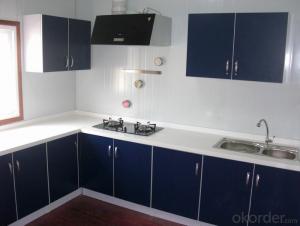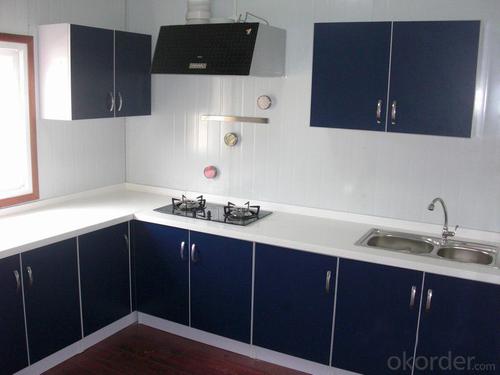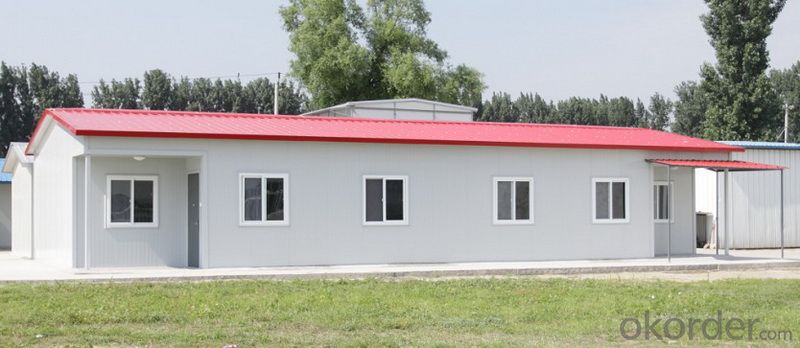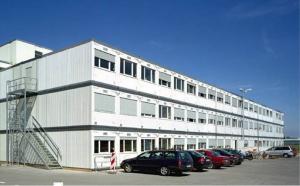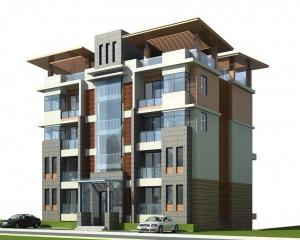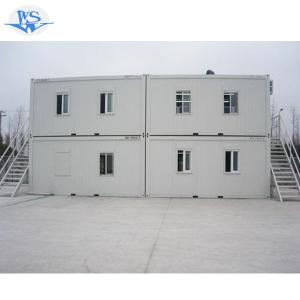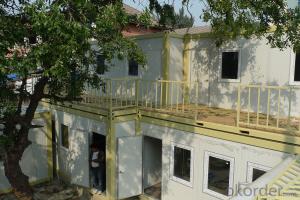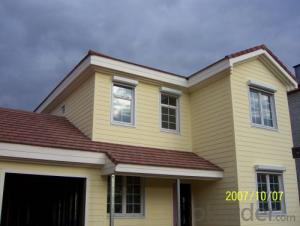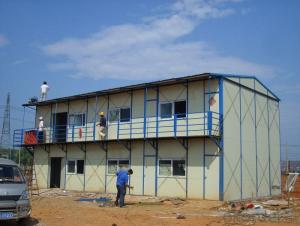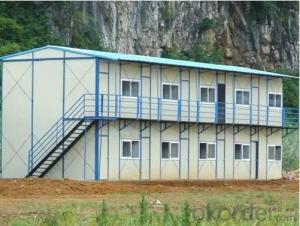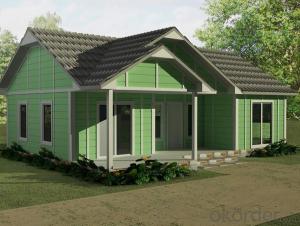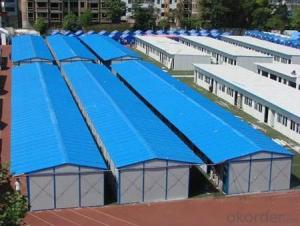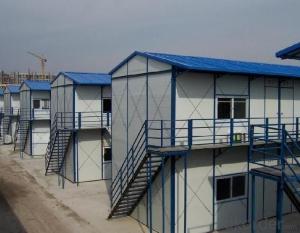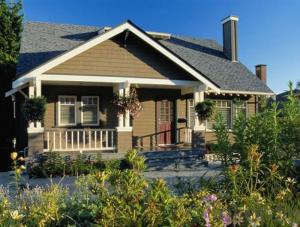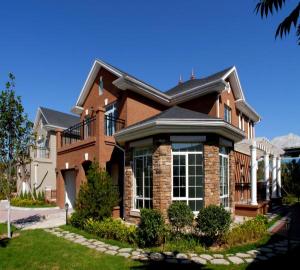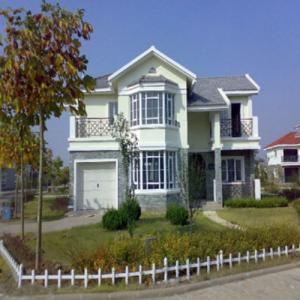Sandwich Panel House with Cheap Price and Beautiful Looking
- Loading Port:
- China main port
- Payment Terms:
- TT OR LC
- Min Order Qty:
- 50 m²
- Supply Capability:
- 100000 m²/month
OKorder Service Pledge
OKorder Financial Service
You Might Also Like
1、Description of Sandwich Panel House :
Sandwich panel house is widely used for short-term office or for accommodation in Mining and construction site. Our portable house is of low cost and can be customized with rational functions like knock down system, quick assemble and disassemble. Welcome to contact us for more details about sandwich panel house. The all steel framing of export prefab house “Green” construction framing and is 100% recyclable. Steel framing is non-combustible; non-toxic and allergy free; and is termite, Insect and rodent resistant. When building with steel, you receive a safer and stronger product that will not contribute fuel to the spread of fire and is termite resistant.Enjoy the safety and environmental friendly advantages of export prefab house.
2.Features of Sandwich Panel House :
1. Customized;
2. Knock down system, quick assemble and disassemble;
3. Low cost;
4. Reuse for several times.
5. Can be lifted on truck and transported to nearby worksite.
3. Sandwich Panel House Images:
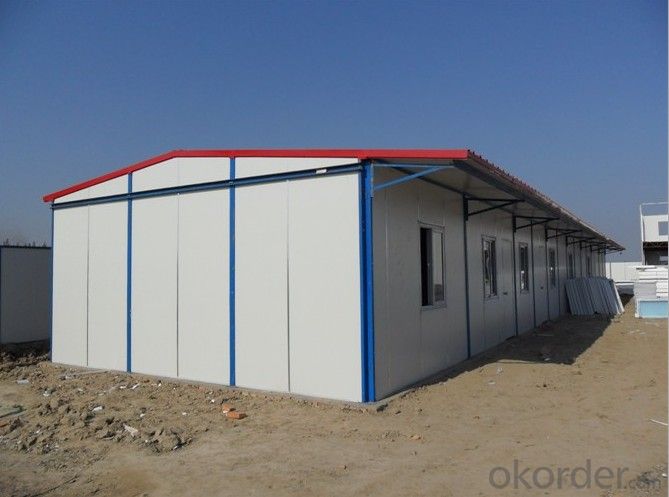
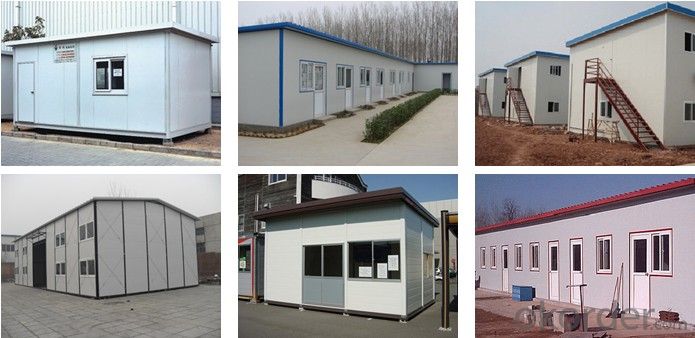
4.Specifications of the Sandwich Panel House:
1. Stable structure: Safe and reliable light steel flexible structure system.
2. Beautiful decoration: Beautiful materials, bright color, flat surface and art decoration.
3. Flexible composition: Doors and windows could be installed at any position, separate wall could
be built at any transverse axis. 4. Easy & quick to install: Repeated use, simple tools for installation. One worker could install 20-30 square meters per day, 6 workers could work out 3K×10K house in two days.
5. Economical: Compared with concrete buildings, it costs much less.
6. Long life span: All the outside steel structure is galvanized, anti-rust, which makes its using life more than 10 years.
5、FAQ
Q1: Why buy Materials & Equipment from OKorder.com?
A1: All products offered by OKorder.com are carefully selected from China's most reliable manufacturing enterprises. Through its ISO certifications, OKorder.com adheres to the highest standards and a commitment to supply chain safety and customer satisfaction.
Q2: How do we guarantee the quality of our products?
A2: We have established an advanced quality management system which conducts strict quality tests at every step, from raw materials to the final product. At the same time, we provide extensive follow-up service assurances as required.
Q3: What is the service life of a Prefabricated House?
A3: The life of a prefabricated house is at least double that of a corresponding concrete building.
Q4: Are Prefabricated Houses safe?
A4: Our houses are completely safe. Advances in the field of prefabricated buildings have reached a point that today Prefabricated Homes are considered safer than traditional homes built with brick. In areas with high seismic activity and in countries prone to extreme weather events residents prefer prefabricated homes for safety reasons.
- Q: Are container houses suitable for educational or learning centers?
- Yes, container houses can be suitable for educational or learning centers. These structures offer versatility and can be easily modified to accommodate different educational needs. They are cost-effective, eco-friendly, and can be designed to provide a conducive learning environment with proper insulation, ventilation, and lighting. Additionally, container houses can be customized to include classrooms, libraries, laboratories, or meeting spaces, making them a practical choice for educational institutions.
- Q: Can container houses be built off-grid?
- Yes, container houses can be built off-grid. Off-grid living refers to living in a self-sufficient manner without reliance on public utilities such as electricity, water, and sewage. Container houses can be modified and designed to meet the requirements of off-grid living. To make a container house off-grid, various systems can be implemented. Solar panels can be installed on the roof to generate electricity, which can be stored in batteries for use during the night or cloudy days. Additionally, a rainwater harvesting system can be set up to collect and store rainwater for daily use, reducing the dependence on municipal water supply. Container houses can also incorporate composting toilets or septic tanks for waste management, eliminating the need for a connection to a sewage system. Greywater recycling systems can be used to treat and reuse wastewater from sinks, showers, and washing machines, reducing water consumption. Furthermore, insulation and ventilation can be optimized to regulate the interior temperature, reducing the need for heating or cooling systems. This can be achieved through the use of energy-efficient windows, insulation materials, and natural ventilation techniques. Container houses offer versatility and can be built in remote locations, making them suitable for off-grid living. With the right modifications and systems in place, container houses can provide a sustainable and self-sufficient living solution.
- Q: Can container houses be built with a home bar or entertainment area?
- Container houses have the potential to incorporate a home bar or entertainment area. These houses offer a versatile and customizable solution for constructing a home, allowing for the inclusion of various amenities such as a home bar or entertainment area. By tailoring the interior design and layout, these spaces can seamlessly blend into the container's structure. For instance, modifications can be made to include a bar counter, storage shelves for beverages, a seating area, and even entertainment systems like TVs or sound systems. Moreover, container houses can be expanded by connecting multiple containers, creating larger living spaces that can accommodate more extensive entertainment areas. By carefully planning and designing, container houses can be transformed into stylish and functional homes that perfectly cater to the homeowner's preferences and lifestyle, while also featuring a home bar or entertainment area.
- Q: Are container houses suitable for bed and breakfast accommodations?
- Absolutely! Bed and breakfast accommodations can definitely benefit from using container houses. The popularity of these houses has skyrocketed in recent years due to their versatility, affordability, and sustainability. They can be easily converted into comfortable and fashionable living spaces, making them an ideal choice for bed and breakfast accommodations. Container houses provide numerous advantages for bed and breakfasts. Firstly, they offer a high level of customization, enabling owners to create unique and personalized spaces for their guests. Additionally, the modular nature of container houses allows for easy expansion or modification of the accommodations based on demand. Moreover, container houses are cost-effective when compared to traditional construction methods. The materials used in building them are often more affordable, and the construction process is quicker, resulting in time and money savings. This affordability can then be passed onto guests, providing them with a more budget-friendly option for their stay. Furthermore, container houses are environmentally friendly. By repurposing shipping containers that would otherwise go to waste, bed and breakfast owners can contribute to sustainability efforts. Container houses can also incorporate energy-efficient features like solar panels, rainwater harvesting systems, and insulation, thereby reducing their carbon footprint. In terms of aesthetics, container houses can be designed to be modern, sleek, and visually appealing. With the assistance of professional architects and designers, container houses can be transformed into stylish accommodations that attract guests seeking unique and Instagram-worthy experiences. In conclusion, container houses are indeed suitable for bed and breakfast accommodations. They offer versatility, affordability, sustainability, and the potential for stunning designs, making them an excellent choice for owners aiming to create memorable experiences for their guests.
- Q: Are container houses suitable for individuals who frequently relocate?
- Container houses are an excellent option for individuals who often move around. The modular and portable nature of these houses makes them perfect for those with a nomadic lifestyle or those who frequently change locations. They are designed to be easily transported and can be moved to different places without much trouble. These houses are constructed using repurposed shipping containers, which are durable and sturdy. They can withstand various weather conditions and can be stacked, making transportation on trucks, trains, or ships easy. This means that individuals can relocate their container house whenever they want to move. Furthermore, container houses can be customized and modified to meet individual needs and preferences. They can easily be expanded or downsized depending on the required space. This flexibility allows individuals to adapt their living space to different locations and accommodate their changing needs. In addition to their mobility and flexibility, container houses are also cost-effective. They generally cost less than traditional houses and require minimal maintenance. The use of shipping containers reduces construction costs, and their durability ensures longevity, reducing the need for repairs or renovations. Container houses also provide sustainability benefits. By repurposing shipping containers, individuals contribute to recycling efforts and reduce the demand for new construction materials. Additionally, container houses can be designed to be eco-friendly, incorporating energy-efficient features and renewable energy sources. To sum up, container houses are highly suitable for individuals who frequently move. Their mobility, flexibility, cost-effectiveness, and sustainability aspects make them an ideal choice for those with a nomadic lifestyle or who need to move frequently.
- Q: Can container houses be easily transported overseas?
- Yes, container houses can be easily transported overseas due to their modular design and standard dimensions that make them compatible with international shipping regulations.
- Q: Are container houses suitable for areas with limited access to construction materials?
- Yes, container houses are suitable for areas with limited access to construction materials. Container houses are constructed using shipping containers, which are readily available and can be transported even to remote areas. These containers provide a strong and sturdy base for building a house, making them suitable for areas with limited access to traditional construction materials. Additionally, container houses can be easily customized and modified to fit the specific needs and climate conditions of the area. They can also be designed to be self-sufficient, incorporating renewable energy sources and water collection systems, further reducing the reliance on external construction materials and resources. Overall, container houses offer a viable solution for areas with limited access to construction materials, providing a quick, cost-effective, and sustainable housing option.
- Q: Can container houses be built with a separate guest house or studio?
- Container houses have the potential to include a separate guest house or studio. The adaptability and modular nature of container houses enable the creation of additional living spaces or structures on the same property. Through the stacking or combining of multiple containers, architects and designers can easily build separate guest houses or studios alongside the primary container house. These extra structures can be tailored to meet specific needs and serve various purposes, such as providing a comfortable space for guests, functioning as a home office or studio, or even being utilized as a rental property. The flexibility of container construction offers a wide array of design possibilities, making it possible to incorporate separate guest houses or studios into container house projects.
- Q: Are container houses suitable for art galleries or exhibition spaces?
- Container houses can indeed be suitable for art galleries or exhibition spaces, depending on the specific needs and vision of the curator or artist. These innovative structures offer several advantages that make them an attractive option for such purposes. Firstly, container houses are highly versatile and customizable. They can be easily modified to create unique and unconventional exhibition spaces, allowing artists to experiment with different layouts and designs. The modular nature of containers also enables easy expansion or downsizing, depending on the size of the exhibition or the number of artworks being displayed. Secondly, container houses are cost-effective. Compared to traditional building materials and methods, containers are relatively inexpensive, making them a budget-friendly choice for artists or gallery owners on a tight budget. This affordability allows for more investment in other aspects of the exhibition, such as artwork acquisition or promotion. Additionally, container houses are portable and movable. They can be easily transported to different locations, providing flexibility for artists who wish to showcase their work in various cities or countries. This mobility also allows for temporary exhibitions in unconventional settings, such as outdoor spaces or remote areas, providing a unique experience for visitors. Furthermore, container houses are environmentally friendly. Recycling shipping containers for exhibition spaces reduces waste and minimizes the carbon footprint associated with construction. This sustainable approach aligns with the increasing demand for eco-friendly practices in the art industry, appealing to environmentally conscious artists, curators, and visitors. However, it is important to consider potential limitations of container houses for art galleries or exhibition spaces. Containers have limited dimensions, which may restrict the size or scale of artworks that can be displayed. Adequate insulation and climate control systems may also be required to ensure the preservation of delicate artworks, especially in extreme weather conditions. In conclusion, container houses can be a suitable and innovative choice for art galleries or exhibition spaces. Their versatility, affordability, portability, and sustainable qualities make them attractive options for artists and curators looking for unconventional and cost-effective solutions. However, careful consideration should be given to specific requirements and limitations to ensure that the container house meets the needs of the artworks and provides a conducive environment for both artists and visitors.
- Q: Are container houses suitable for remote work or telecommuting?
- Indeed, container houses have the potential to serve as appropriate options for remote work or telecommuting. Typically, these houses are designed to be adaptable and can be customized to establish a workspace that is both comfortable and functional. By ensuring adequate insulation, heating, cooling, and ventilation systems, container houses can create a conducive environment for remote work. Modifying container houses to include dedicated office spaces or workstations is a straightforward process. These spaces can be equipped with all the necessary amenities such as desks, chairs, shelving, and storage. Moreover, container houses can be designed to maximize natural light and provide scenic views, thus fostering a pleasant working atmosphere. The portability of container houses is another advantage worth considering. These houses can be easily transported to remote locations, enabling individuals to work from any place they desire. This flexibility proves advantageous for those who seek a change of scenery or need to relocate frequently due to work commitments. Furthermore, container houses often present a cost-effective alternative to traditional houses, making them an appealing choice for remote workers looking to save on housing expenses. They require less maintenance and can be more energy-efficient, thereby reducing utility costs. Nevertheless, it is vital to acknowledge some limitations of container houses for remote work. The limited space within these houses may not cater to individuals who require a sizable workspace or have specific equipment needs. Additionally, the noise insulation in container houses might not be as effective as in traditional houses, which could pose a challenge for individuals engaging in frequent online meetings or conference calls. To conclude, due to their versatility, affordability, and portability, container houses can represent an excellent option for remote work or telecommuting. With appropriate modifications, they have the potential to provide a comfortable and functional workspace, enabling individuals to engage in remote work within a distinctive and sustainable environment.
Send your message to us
Sandwich Panel House with Cheap Price and Beautiful Looking
- Loading Port:
- China main port
- Payment Terms:
- TT OR LC
- Min Order Qty:
- 50 m²
- Supply Capability:
- 100000 m²/month
OKorder Service Pledge
OKorder Financial Service
Similar products
Hot products
Hot Searches
